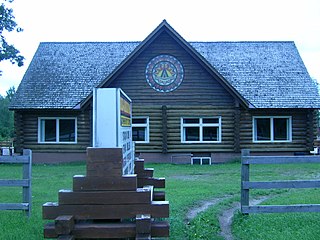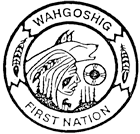
McGarry is an incorporated township in Timiskaming District in Northeastern Ontario, Canada. It includes the communities of Virginiatown, North Virginiatown, and Kearns. The township borders with Quebec to the east, along Highway 66 between Kirkland Lake and Rouyn-Noranda. The northern border of the township forms part of the border between Timiskaming District and Cochrane District. Highway 66 was rerouted in 2017 because of concerns that aging mine shafts under the road could cause it to collapse.
Bear Island is an island in Lake Temagami of Northeastern Ontario, Canada. With an area of 4.66 km2 (1.80 sq mi), it is the second largest island in Lake Temagami after Temagami Island. Much of Bear Island is in Joan Township, a geographic township that also includes the Joan Peninsula to the northwest.

Lady Evelyn-Smoothwater Provincial Park is a remote wilderness park in northeastern Ontario, Canada, north of Lake Temagami. This operating park, requiring permits for all visitors, encompasses "rugged topography, clear lakes, stunning waterfalls, and rushing rivers".

Garden River First Nation, also known as Ketegaunseebee, is an Ojibwa band located at Garden River 14 near Sault Ste. Marie, Ontario, Canada.
The Robinson Treaties are two treaties signed between the Ojibwa chiefs and the Crown in 1850 in the Province of Canada. The first treaty involved Ojibwa chiefs along the north shore of Lake Superior, and is known as the Robinson Superior Treaty. The second treaty, signed two days later, included Ojibwa chiefs from along the eastern and northern shores of Lake Huron, and is known as the Robinson Huron Treaty. The Wiikwemkoong First Nation did not sign either treaty, and their land is considered "unceded".

Temagami, formerly spelled Timagami, is a municipality in northeastern Ontario, Canada, in the Nipissing District with Lake Temagami at its heart.
Temagami Island, formerly spelt as Timagami Island, is an island in Lake Temagami in Northeastern Ontario, Canada. It is the largest island within the lake, with Bear Island coming second. The island has many hiking trails that lead into the old-growth forest that is a mix of large white and red pine trees. Temagami Mine, later known as Copperfields Mine, was a copper mine that opened on Temagami Island in 1954. It was considered to be the largest deposit of nearly pure chalcopyrite ever discovered in Canada. The mine closed in 1972.

Apitipi Anicinapek Nation, formerly known as Wahgoshig First Nation, is an Algonquin Anicinape community, located near Matheson in Cochrane District in northeastern Ontario, Canada. In January 2008, the First Nation had 270 people registered with the nation, of which their on-reserve population was 121.
The White Bear Forest is an old growth forest, located in Temagami, Ontario, Canada. The forest is named after Chief White Bear, who was the last chief of the Teme-Augama Anishnabai before Europeans appeared in the region. In some parts of the White Bear Forest trees commonly reach 200 to 300 years in age, while the oldest tree accurately aged in White Bear Forest was a red pine that was 400 years old in 1999. The White Bear Forest contains one of Canada's oldest portages, dating back some 3,000 years. Today, more than 17 km (11 mi) of trails access the White Bear Forest. A trail guide is available online at http://ancientforest.org/whitebear.html.

The Teme-Augama Anishnabai is the Indigenous Anishinaabe community of the Temagami First Nation. The ancestors of Teme-Augama Anishnabai have trapped and hunted animals in the Temagami region of Canada for over 5,000 years. Bear Island on Lake Temagami is home to the Indigenous community.
Gary Potts was a chief of the Temagami First Nation and the Teme-Augama Anishnabai in Temagami, Ontario, Canada. He was chief in August 1973 when the Temagami Land Caution began with land claims being filed with title offices to prevent development on Crown land.

The Temagami Magnetic Anomaly, also called the Temagami Anomaly or the Wanapitei Anomaly, is a magnetic anomaly resulting from a large buried geologic structure in the Canadian Shield near Temagami, Ontario, Canada. It stretches from Lake Wanapitei in the west to Bear Island in Lake Temagami.

Rib Lake is a long and narrow lake in the Town of Latchford and in the Municipality of Temagami in Northeastern Ontario, Canada, located about 9 kilometres (6 mi) southeast of the centre of the community of Latchford and 9 kilometres (6 mi) northeast of the community of Temagami North. The lake is in the Ottawa River drainage basin and is the main access for canoeists en route to Rib Mountain.

Bruce Allan Clark is a Canadian native rights lawyer, writer and activist. He rose to attention as part of the Gustafsen Lake Standoff and its aftermath.
The Temagami Land Caution was a territorial dispute in the Temagami area of Northeastern Ontario, Canada. In 1877, deputy chief Ignace Tonené filed a land claim concerning the Temagami region with the Parry Sound federal Indian Agent. The modern land claim was filed with land title offices in August 1973 by Gary Potts, then Chief of the Teme-Augama Anishnabai Indigenous Nation. The caution was intended as a way of maintaining 10,000 km2 (3,900 sq mi) of land that they claimed as "n'Daki Menan", meaning "Our Land". Existing throughout much of the 1970s and 1980s, it effectively prevented all types of development on Crown land, such as mining. Crown land sales were also prohibited due to the Temagami Land Caution. In 1988, Vince Kerrio approved the expansion of Red Squirrel Road directly through the Temagami Land Caution. This prompted a series of roadblocks by the Teme-Augama Anishnabai and by environmentalists in 1988–1989. In 1991, the Supreme Court of Canada ruled that the Teme-Augama Anishnabai gave up rights to the land via the 1850 Robinson Treaty despite the Tema-Augama Anishnabai claiming that they never signed or consented to the treaty. The Temagami Land Caution was lifted in 1995 as a result of a court order by the Supreme Court of Canada.

The Caldwell First Nation is a First Nations band government whose land base is located in Leamington, Ontario, Canada. They are an Anishinaabe group, part of the Three Fires Confederacy, comprising the bands Potawatomi, Odawa, and Ojibwa, whose members are originally of the Mikinaak (Turtle) and the Makwa (Bear) dodems. The Caldwell First Nation are a distinct and federally recognized Indian band and used to be referred to by such names as the "Chippewas of Pelee", "Point Pelee Indians" and "Caldwell's band of Indians."

Ignace Tonené, also known as Nias or by his Ojibwe name Maiagizis, was a Teme-Augama Anishnabai chief, fur trader, and gold prospector in Upper Canada. He was a prominent employee of the Hudson's Bay Company.
Chief Tonene Lake is a lake in the Timiskaming District of Ontario, Canada.
White Bear was a Temagami First Nation chief.
Peter Nebenegwune, commonly known as Nebenegwune, was the head chief, of the Temagami First Nation in Ontario, Canada.













